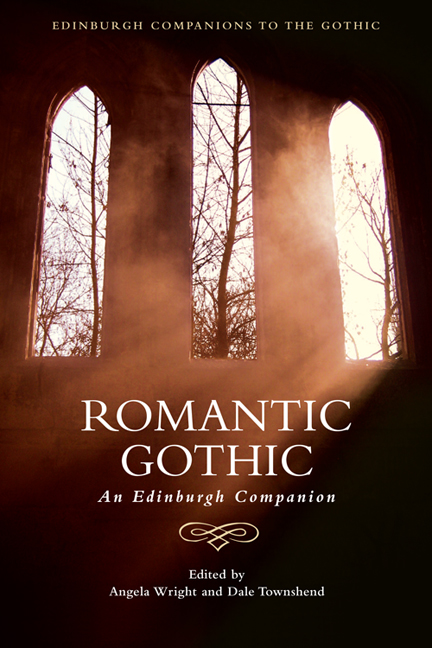Book contents
- Frontmatter
- Contents
- 1 Gothic and Romantic: An Historical Overview
- Part I Gothic Modes and Forms
- Part II National and International Borders
- Part III Reading the Romantic Gothic
- 15 Gothic and the Language of Terror
- 16 Gothic Science
- 17 Gender and Sexuality in Gothic Romanticism
- 18 Gothic Forms of Time: Architecture, Romanticism, Medievalism
- 19 Gothic Theology
- Notes on Contributors
- Index
18 - Gothic Forms of Time: Architecture, Romanticism, Medievalism
from Part III - Reading the Romantic Gothic
Published online by Cambridge University Press: 05 August 2016
- Frontmatter
- Contents
- 1 Gothic and Romantic: An Historical Overview
- Part I Gothic Modes and Forms
- Part II National and International Borders
- Part III Reading the Romantic Gothic
- 15 Gothic and the Language of Terror
- 16 Gothic Science
- 17 Gender and Sexuality in Gothic Romanticism
- 18 Gothic Forms of Time: Architecture, Romanticism, Medievalism
- 19 Gothic Theology
- Notes on Contributors
- Index
Summary
Watching flames ravage the Palace of Westminster on 16 October 1834, the correspondent for the Gentleman's Magazine felt, ‘as an antiquary and a British subject’, ‘as if a link would be burst asunder in my national existence’. With the loss of this ‘giant of the Gothic age’, ‘the history of my native land was about to become … a dream’ (Gentleman's Magazine 1834: 477). This vision of personal ‘national existence’ in architectural form opens up a hall of mirrors reaching far into British cultural and constitutional history. The writer's words resonate with Horace Walpole in the 1760s condensing into ‘Gothic Story’ his own dreams of ancient architecture, the poetic ‘canon’ of Shakespeare, and the long tradition dating back to the 1600s of writing ‘English history as Gothic history’ (Silver 2014: 3). They also anticipate John Ruskin in the mid-nineteenth century, classifying the historical sense into ‘Classicalism, Mediaevalism, and Modernism’, and defining the newly coined ‘medievalism’ as a ‘Gothic form’ of society, fusing ‘architecture’, ‘religion’ and ‘national life and character’ (Ruskin 1854: 21, 193; Peterson in Tucker 2014: 405–6).
But the ‘Gothic’ vision expressed in the Gentleman's Magazine in 1834 is not precisely that of either Walpole or Ruskin. ‘Romantic Gothic’ is perhaps a better description. The Romantic period is defined by an emotive public debate about reform to what William Blackstone metaphorically described as the ‘castle’ of the ‘Gothic constitution’. Samuel Taylor Coleridge felt after the 1832 Reform Act that ‘England is – no more!’ (Gilmartin 2007: 252). The prospect of Reform and Catholic Emancipation drove the sometime utopian Robert Southey, the period's ‘only existing entire man of letters’, to pass his ‘days among the dead’, communing with the ghosts of England in the 1530s (Madden 1972: 157; Southey 2012: I.313–4). After the Act, William Wordsworth altered his ‘history of a poet's mind’ to make St John's, Cambridge, not just ‘gloomy’ but ‘Gothic’, having already in 1832 added a scene of Edmund Burke in old St Stephen's Chapel, Westminster, proclaiming the ‘majesty … / Of Institutes and Laws, hallowed by time’ (Wordsworth 1995: [1850], Book III, 47; VII, 525–6).
- Type
- Chapter
- Information
- Romantic GothicAn Edinburgh Companion, pp. 339 - 360Publisher: Edinburgh University PressPrint publication year: 2015



